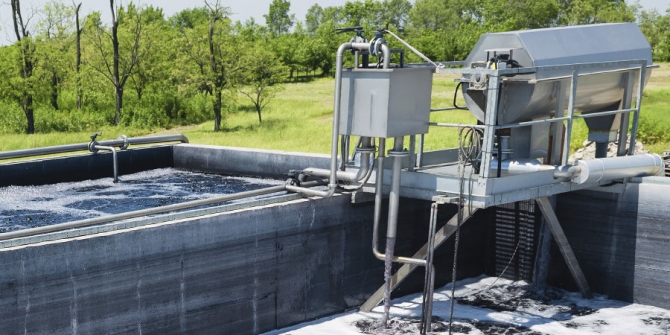If you were shocked by the recent contamination of Lancashire’s water supply,i spare a thought for the employees that routinely deal with the UK’s 650,000km sewerage network.ii Not only do these workers average at least one episode of work-related illness each year, they often face this, and many other risks, alone.iii
Confronted with the challenge of keeping an enormous and widely dispersed sewerage network running efficiently around-the-clock, many water industry employees must work by themselves, in remote locations and at unusual times. Yet for those in direct contact with sewage the risks become even more complex. Unlike almost any other industry, sewage workers face a diverse set of environmental, biological, chemical and atmospheric hazards, which frequently combine in unpredictable ways.
Falling foul of hazards
In the sewage industry biological contamination is an ever-present risk, with employees regularly exposed to harmful bacteria, viruses and parasites in the course of their work. While the vast majority of exposure simply results in mild gastroenteritis, the Health & Safety Executive has seen reported cases of potentially fatal diseases like Hepatitis.
Microorganisms will seize any chance to enter the body: a forgetful wipe of the face with a contaminated glove, an open cut, or unfiltered breathing is all it takes in some cases. Since symptoms also take time to appear, the Health & Safety Executive expects “significant under-reporting” of work-related illnesses - meaning that underlying safety failures are often never investigated, understood and resolved.iv
Of course, decomposing sewage also creates a wide variety of other risks, such as noxious fumes, reduced oxygen levels, or even spontaneous explosions due to methane and other flammable gases. The dangers are particularly stark for sewage workers in confined spaces like man holes, trunk sewers or storage tanks where limited access combines with patchy or non-existent mobile coverage to make a swift response by the emergency services challenging at best. Rescuers must also have immediate access to the right equipment (such as breathing apparatus) or they will quickly find themselves in the same difficulty as those they are trying to help.
Even in the comparatively controlled environment of water treatment plants, there are considerable risks. Employees frequently work out of sight of colleagues, automatic machinery can start without warning, deep or fast-flowing water is common and other dangers like high noise levels, noxious fumes or hazardous chemicals also come into play. Situations can get out of hand quickly; for instance, as recently as July 2015, an engineer for Yorkshire Water was tragically killed in an industrial fire at Tadcaster sewage works.v
Eliminating risk
While sewage industry hazards can be significantly reduced, they will never be completely eradicated due to the nature of the work. As part of this on-going process, the welfare of lone workers should be made a top priority, as they’re often the most vulnerable employees.
At the outset, it’s critical to conduct detailed risk assessments, create emergency response plans and educate staff on the dangers, ensuring they’re trained to evaluate and cope with potential hazards. Employers should also put in place regular health checks to identify work-related illnesses effectively and resolve any underlying safety problems.
With careful upfront planning, sewage companies can safeguard employees appropriately, such as providing the right protective clothing and equipment. If employees are working in areas where sewage spray is a known problem for instance, face visors should be issued. Hygienic washing facilities and adequate first-aid equipment should also be available, whether an employee is onsite or in a remote location.
Alongside these precautions, the ability to communicate with and monitor lone workers effectively should not be forgotten. Sewage workers must have a reliable means to summon help as quickly as possible, even in underground areas with patchy mobile coverage or if they are incapacitated and unable to sound the alarm. LONEALERT’s Man Down Plus solution is a good example of this in action: delivering GPS location tracking from a fully waterproof handset with an ATEX option that also makes the device suitable for use in areas with an explosive risk. When Man Down Plus detects falls or long periods of inactivity, it audibly warns the user and then raises an alert if there’s no response. Multi-network SIM cards can also be added so that the device always roams to the strongest available mobile network for improved connectivity.
Ultimately, with a proactive approach and the right innovative technologies, every sewage company can ensure that safety never stagnates. Lone workers may be out of sight, but they should never be out of mind.
- BBC News online, Lancashire boiled water 'safe' amid cryptosporidium alert – officials, 2015: http://www.bbc.co.uk/news/uk-england-lancashire-33833340
- Clear First, The UK Water Industry – Every Drop Counts, 2015: http://www.clearfirstwatermainreplacement.co.uk/uk-water-industry-infographic/
- HSE, Working with sewage, 2011: http://www.hse.gov.uk/pubns/indg198.pdf
- HSE, Working with sewage, 2011: http://www.hse.gov.uk/pubns/indg198.pdf
- BBC News online, Man dies in Tadcaster sewage works accident, 2015: http://www.bbc.co.uk/news/uk-england-york-north-yorkshire-33636616







